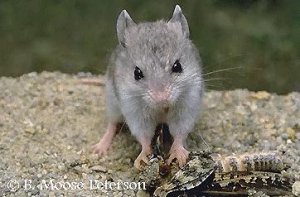Endangered Species Recovery Program | |
|
Home | News | Publications | Species profiles | Data and maps | About | Staff | Links | Department of Biological Sciences | CSU Stanislaus |

Tulare grasshopper mouse
Onychomys torridus tularensis
Status
California Species of Concern
Life History
The Tulare grasshopper mouse, a subspecies of the southern grasshopper mouse, fits the general description of the genus Onychomys by having a stout body with a short, club-like tail. They are sharply bicolored with the head and upperparts pale brown to gray or pinkish- cinnamon and the underparts white. The tail is usually bicolored with a white tip. The young and subadults are gray in color. The feet of the southern grasshopper mouse have five tubercles (knob-like fleshy bumps) on the sole of each forefoot and four on the hindfeet.
The grasshopper mouse is primarily a carnivore, with a particular appetite for small mammals and insects; it also eats other invertebrates and seeds.
Specific information on the reproduction and mating system of the Tulare grasshopper mouse is unknown. For the southern grasshopper mouse, which lives in burrows, breeding is seasonal with the young born from May through July. Captive populations of this species breed throughout the year and gestation is between 27 and 32 days. In the wild, up to 3 litters per year may be produced.
The adult males are highly territorial and frequently vocalize at night. They emit a high-pitched call, lasting several seconds, while standing on their hind legs with head raised and mouth open.
Typically, Tulare grasshopper mice inhabit arid shrubland communities in hot, arid grassland and shrubland associations. These include blue oak woodlands at 450 m (1476 feet); upper sonoran subshrub scrub community; alkali sink and mesquite associations on Valley Floor; and grasslands associations on the sloping margins of the San Joaquin Valley and Carrizo Plain region. Specific habitat requirements are unknown.
Like most of the other sensitive species of the San Joaquin Valley, habitat reduction, fragmentation, and degradation are the principal causes of the decline of the Tulare grasshopper mouse. Use of insecticides may have contributed to the extirpation of this species from fragmented habitat on the Valley floor by reducing their main food source and from both direct and indirect poisoning.
Distribution
Historically, the Tulare grasshopper mouse ranged from western Merced and eastern San Benito counties east to Madera County and south to the Tehachapi Mountains. Currently, they are known to occur in these areas: along the western margin of the Tulare Basin, including western Kern County; Carrizo Plain Natural Area; along the Cuyama Valley side of the Caliente Mountains, San Luis Obispo County; and the Ciervo-Panoche Region, in Fresno and San Benito counties.
Classification
Order RODENTIA, Family CRICETIDAE, Genus Onychomys, Species torridus
Subspecies
O. torridus tularensis, Tulare grasshopper mouse, is one of ten recognized subspecies of the southern grasshopper mouse.
Recent Synonyms
None
Other Common Names
None
References
Bailey, V., and C.C. Sperry. 1929. Life history and habits of grasshopper mice, genus Onychomys. U.S. Dept. Agriculture, Tech. Bulletin 145:1-19; Taylor, J.M. 1968. Reproductive mechanisms of the female southern grasshopper mouse, Onychomys torridus longicaudus. J. Mammalogy 49:303-309; McCarty, R. 1975. Onycomys torridus. Mammalian Species, 59:1-5; Williams, D.F. and K.S. Kilburn. 1992. The conservation status of the endemic mammals of the San Joaquin Faunal Region, California. Pp. 329-345, in Endangered and Sensitive Species of the San Joaquin Valley, California (D.F. Williams, S. Byrne, and T.A. Rado, eds.). California Energy Commission, Sacramento, 388 pp.
Size
Body length:
119-163 mm (4.69-6.42 inches)
Hind foot length:
18-23 mm (0.71-0.91 inches)
Tail length:
33-62 mm (1.3-2.44 inches)
Identification
The Tulare grasshopper mouse looks similar to the white-footed mouse (Peromyscus spp.); however, the grasshopper mouse has a shorter, thicker tail, and has larger forefeet than the white-footed mouse.
Authors of Pprofile
N. L. Brown and D.F. Williams